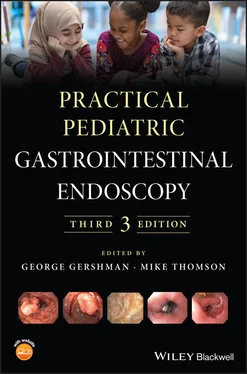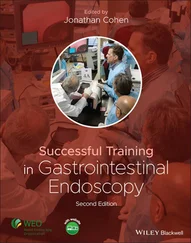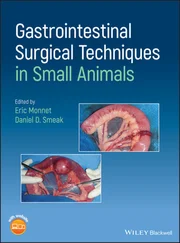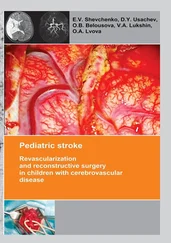11 11 Cremer M, Rodesch P, Cadranel S. Fiberendoscopy of the gastrointestinal tract in children. Experience with newly designed fiberscopes. Endoscopy 1974, 6, 186–189.
12 12 Rodesch P, Cadranel S, Peeters JP. Digestive endoscopy with fiberoptics in children. Acta Paediatr Scand 1974, 63, 664.
13 13 Gleason PD, Tedesco FJ, Keating WA. Fiberoptic gastrointestinal endoscopy in infants and children. J Pediatr 1974, 85, 810–813.
14 14 Gans SL, Ament ME, Christie DL, Liebman WM. Pediatric endoscopy with flexible fiberscopes. J Pediatr Surg 1975, 10, 375–380.
15 15 Rodesch P, Cadranel S, Peeters JP, et al. Colonic endoscopy in children. Acta Paediatr Belg 1976, 29, 181–184.
16 16 Mougenot JF, Montagne JP, Faure C. Gastrointestinal fibro‐endoscopy in infants and children: radio‐fibroscopic correlations. Ann Radiol (Paris) 1976, 19, 23–34.
17 17 Vanderhoof JA, Ament ME. Proctosigmoidoscopy and rectal biopsy in infants and children. J Pediatr 1976, 89, 911–915.
18 18 Forget PP, Meradji M. Contribution of fiberendoscopy to diagnosis and management of children with gastroesophageal reflux. Arch Dis Child 1976, 51, 60–66.
19 19 Ament ME, Christie DL. Upper gastrointestinal endoscopy in pediatric patients. Gastroenterology 1977, 72, 492–494.
20 20 Cadranel S, Rodesch P. Pediatric endoscopy in children: preparation and sedation. Gastroenterology 1977, 71, 44–45.
21 21 Cadranel S, Rodesch P, Peeters JP, et al. Fiberendoscopy of the gastrointestinal tract in children and infants: a series of 100 examinations. Am J Dis Child 1977, 131, 41–45.
22 22 Gyepes MT, Smith LE, Ament ME. Fiberoptic endoscopy and upper gastrointestinal series: comparative analysis in infants and children. Am J Roentgenol 1977, 128, 53–56.
23 23 Graham DY, Klish WJ, Ferry GD, Sabel JS. Value of fiberoptic gastrointestinal endoscopy in infants and children. South Med J 1978, 71, 558–560.
24 24 Rumi G, Solt I, Kajtar P. Esophagogastroduodenoscopy in childhood. Acta Paediatr Acad Sci Hung 1978, 19, 315–318.
25 25 Isakova IF, Stepanov EA, Geraskin VI, et al. Fibroscopy in diagnosis of diseases of the upper digestive tract in children. Khirurgiia (Mosk) 1977, 7, 33–37.
26 26 Mazurin AV, Gershman GB, Zaprudnov A, et al. Esophagogastroduodenoscopy of children at a polyclinic. Vopr Okhr Materin Det 1978, 23, 3–7.
27 27 Gershman GB, Bokser VO. Fibrogastroscopy in the diagnosis of gastritis in children. Vopr Okhr Materin Det 1979, 24, 25–30.
28 28 Beltran S, Varea V, Vilar P. Fibroendoscopia en Patologia Digestiva Infantil. Jims, Barcelona, 1980.
29 29 Burdelski M, Huchzermeyer H. Gastrointestinale Endoscopie im Kindesalter. Springer‐Verlag, Berlin, 1980.
30 30 Gans S.L. (ed.). Pediatric Endoscopy. Grüne and Stratton, New York, 1983.
31 31 Gershman G, Ament ME (eds). Practical Pediatric Gastrointestinal Endoscopy. Blackwell, Oxford, 2007.
32 32 Ament ME, Gershman G. Pediatric colonoscopy. In: Waye JD, Rex DK, Williams C (eds). Colonoscopy Principles and Practice. Blackwell, Oxford, 2003, pp. 624–629.
33 33 Winter HS, Murphy MS, Mougenot JF, Cadranel S (eds). Pediatric Gastrointestinal Endoscopy: Textbook and Atlas. BC Decker, Hamilton, 2006.
34 34 Thomson M. Training in pediatric endoscopy. In: Winter HS, Murphy MS, Mougenot JF, Cadranel S (eds). Pediatric Gastrointestinal Endoscopy: Textbook and Atlas. BC Decker, Hamilton, 2006, pp. 34–41.
35 35 Ferlitsch A, Glauninger P, Gupper A, et al. Evaluation of a virtual endoscopy simulator for training in gastrointestinal endoscopy. Endoscopy 2002, 34, 698–702.
36 36 Thomson M, Heuschkel R, Donaldson N, Murch S, Hinds R. Acquisition of competence in paediatric ileocolonoscopy with virtual endoscopy training. J Pediatr Gastroenterol Nutr 2006, 43, 699–701.
37 37 Haycock A, Koch AD, Familiari P, et al. Training and transfer of colonoscopy skills: a multinational, randomized, blinded, controlled trial of simulator versus bedside training. Gastrointest Endosc 2010, 71, 298–307.
38 38 Obstein KL, Patil VD, Jayender J, et al. Evaluation of colonoscopy technical skill levels by use of an objective kinematic‐based system. Gastrointest Endosc 2011, 73, 315–321.
39 39 Urs AN, Martinelli M, Rao P, Thomson MA. Diagnostic and therapeutic utility of double‐balloon enteroscopy in children. J Pediatr Gastroenterol Nutr 2014, 58, 204–212.
40 40 Iddan G, Meron G, Glukhovsky A, Swain P. Wireless capsule endoscopy. Nature 2000, 405, 417.
41 41 Oliva S, Di Nardo G, Hassan C, et al. Second‐generation colon capsule endoscopy vs. colonoscopy in pediatric ulcerative colitis: a pilot study. Endoscopy 2014, 46, 485–492.
Harpreet Pall
 KEY POINTS
KEY POINTS
Well‐designed endoscopy units are essential to providing high‐quality care in pediatric gastroenterology.
Meticulous disinfection of the instruments is a vital component of patient safety.
Appropriate staffing models are important to the safety and success of endoscopy.
Process and quality improvement activities are a key component of unit management.
Close attention to the equipment needed for pediatric endoscopy is necessary.
Proper design of the pediatric endoscopy unit is crucial to the experience of the patient as well as the efficiency of the endoscopy team. Pediatric‐focused facilities prioritize the child and family experience with the goal of reducing patient anxiety and providing age‐appropriate analgesia [1,2]. Design and management of the endoscopy unit needs to be specialized for this unique patient population. A calming environment and smooth patient flow are critical. Ideally, encounters between preprocedure and postprocedure patients should be minimized.
In the United States, endoscopy procedures in children are performed in a variety of locations, including operating rooms, procedure rooms, dedicated endoscopy suites, and ambulatory surgery centers [1,2]. In low‐volume centers, use of the operating room may be appropriate. For those units located in general hospitals, a combined adult/pediatric unit can offer cost savings in terms of equipment and facilities, as well as close proximity for pediatric endoscopists to adult therapeutic endoscopists. Recent survey data suggest up to 40% of centers in the United States currently perform endoscopy in a dedicated pediatric endoscopy unit [1]. Sharing space with other specialties such as pulmonology may be an option, but this can decrease the ability to customize the space for gastrointestinal endoscopy.
An endoscopy suite with at least two procedure rooms is desirable depending on the number of endoscopists and volume of procedures. Two rooms allow for concurrent procedures to take place and the ability to perform emergent inpatient procedures. Adult teaching hospitals are generally expected to do 1000 procedures per room per year [3]. In addition, the unit can include a motility room, capsule endoscopy viewing room, and advanced endoscopy room for fluoroscopic procedures. Plans for designing a pediatric endoscopy unit should include anticipated volume, procedural complexity, and growth of the unit over time. Considerations of space are difficult and carry the greatest implications for overall construction costs [4].
All units should have a reception area and waiting room, where children and caregivers are greeted when they first arrive. The waiting areas should be child friendly. Bathrooms should be easily accessible, with special considerations for obese patients or handicapped patients in a wheelchair. Once escorted into the unit, patients require a clear area to be prepared for the procedure. From this area, the patient is transported directly to the procedure area. In general, a procedure room should be at least 400 square feet with more space often needed for advanced therapeutic cases involving fluoroscopy. Two separate doors should provide access to the procedure rooms: one to allow for the entry of the patient and clean supplies and the other for the removal of used equipment and specimens. Procedure rooms should be equipped to provide CO 2, oxygen, suction, and adequate electrical socket outlets for ancillary equipment. Ceiling‐mounted booms may be helpful in keeping lines and equipment off the floor. One side of the room should be dedicated to nursing. Anesthesia and associated medications and supplies should be located at the head of the bed. After the procedure, a dedicated space for immediate and/or final recovery is needed.
Читать дальше

 KEY POINTS
KEY POINTS







